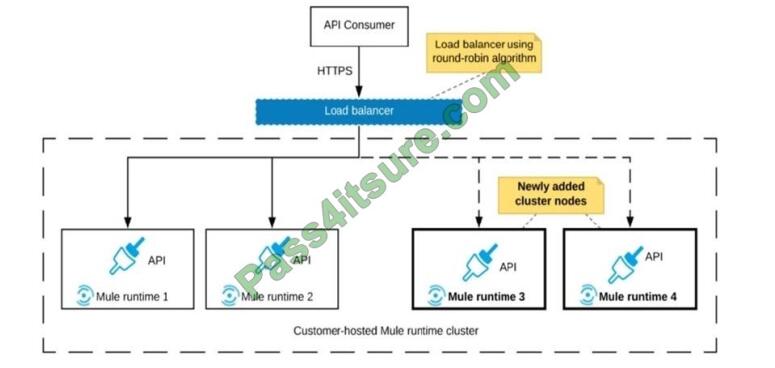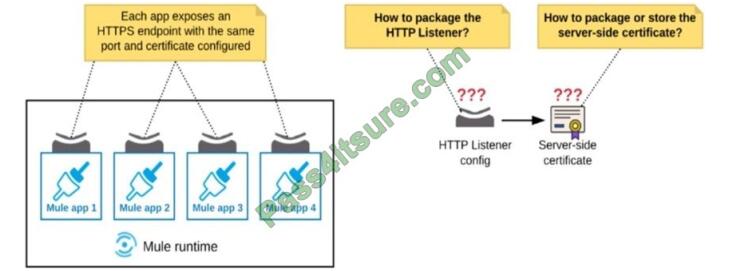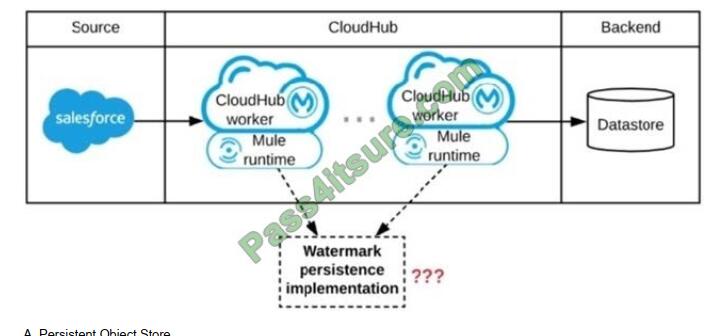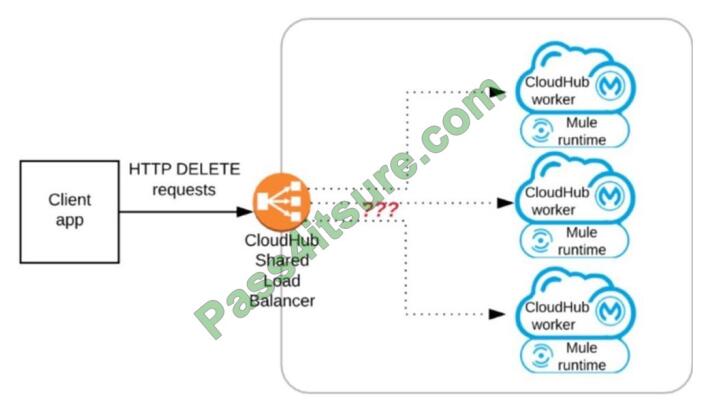Pass4itsure shares a valid Mulesoft MCIA-LEVEL-1 practice test to help pass the Mulesoft MCIA-LEVEL-1 exam! The latest Mulesoft MCIA-LEVEL-1 VCE dumps and Mulesoft MCIA-LEVEL-1 PDF dumps, Pass4itsure Mulesoft MCIA-LEVEL-1 exam questions have been updated https://www.pass4itsure.com/mcia-level-1.html (58 Q&As Dumps)
free Mulesoft MCIA-LEVEL-1 exam pdf dumps https://drive.google.com/file/d/1TrYImHP8rj3e5sxY_eoHSKSjx4tnZ72Y/view?usp=sharing
Share free Mulesoft MCIA-LEVEL-1 exam questions – Pass4itsure
Free Mulesoft MCIA-LEVEL-1 exam pdf dumps download from Google Drive
[q1-q13, free pdf] Mulesoft MCIA-LEVEL-1 exam pdf dumps https://drive.google.com/file/d/1TrYImHP8rj3e5sxY_eoHSKSjx4tnZ72Y/view?usp=sharing
Practice Mulesoft MCIA-LEVEL-1 exam question 1-13
QUESTION 1
What comparison is true about a CloudHub Dedicated Load Balancer (DLB) vs. the CloudHub Shared Load Balancer
(SLB)?
A. Both a DLB and the SLB implement load balancing by sending HTTP requests to workers with the lowest workloads
B. Both a DLB and the SLB allow the configuration of access control via IP whitelists
C. Only a DLB allows the configuration of a custom TLS server certificate
D. Only the SLB can forward HTTP traffic to the VPC-internal ports of the CloudHub workers
Correct Answer: B
QUESTION 2
Refer to the exhibit. An organization uses a 2-node Mule runtime cluster to host one stateless API implementation. The
API is accessed over HTTPS through a load balancer that uses round-robin for load distribution.
Two additional nodes have been added to the cluster and the load balancer has been configured to recognize the new
nodes with no other change to the load balancer.
What average performance change is guaranteed to happen, assuming all cluster nodes are fully operational?

A. 50% reduction in the response time of the API
B. 100% increase in the throughput of the API
C. 50% reduction in the JVM heap memory consumed by each node
D. 50% reduction in the number of requests being received by each node
Correct Answer: C
QUESTION 3
Refer to the exhibit. An organization deploys multiple Mule applications to the same customer-hosted Mule runtime.
Many of these Mule applications must expose an HTTPS endpoint on the same port using a server-side certificate that
rotates often.
What is the most effective way to package the HTTP Listener and package or store the server-side certificate when
deploying these Mule applications, so the disruption caused by certificate rotation is minimized?

A. Package the HTTPS Listener configuration in a Mule DOMAIN project, referencing it from all Mule applications that
need to expose an HTTPS endpoint Store the server-side certificate in a shared filesystem location in the Mule
runtime\\’s classpath, OUTSIDE the Mule DOMAIN or any Mule APPLICATION
B. Package the HTTPS Listener configuration in a Mule DOMAIN project, referencing it from all Mule applications that
need to expose an HTTPS endpoint Package the server-side certificate in ALL Mule APPLICATIONS that need to
expose an HTTPS endpoint
C. Package the HTTPS Listener configuration in a Mule DOMAIN project, referencing it from all Mule applications that
need to expose an HTTPS endpoint Package the server-side certificate in the SAME Mule DOMAIN project
D. Package an HTTPS Listener configuration in all Mule APPLICATIONS that need to expose an HTTPS endpoint
Package the server-side certificate in a NEW Mule DOMAIN project
Correct Answer: A
QUESTION 4
What is true about the network connections when a Mule application uses a JMS connector to interact with a JMS
provider (message broker)?
A. The JMS connector supports both sending and receiving of JMS messages over the protocol determined by the JMS
provider
B. The AMQP protocol can be used by the JMS connector to portably establish connections to various types of JMS
providers
C. To receive messages into the Mule application, the JMS provider initiates a network connection to the JMS connector
and pushes messages along this connection
D. To complete sending a JMS message, the JMS connector must establish a network connection with the JMS
message recipient
Correct Answer: D
QUESTION 5
A Mule application contains a Batch Job with two Batch Steps (Batch_Step_1 and Batch_Step_2). A payload with 1000
records is received by the Batch Job.
How many threads are used by the Batch Job to process records, and how does each Batch Step process records
within the Batch Job?
A. Each Batch Job uses SEVERAL THREADS for the Batch Steps Each Batch Step instance receives ONE record at a
time as the payload, and BATCH STEP INSTANCES execute IN PARALLEL to process records and Batch Steps in
ANY order as fast as possible
B. Each Batch Job uses SEVERAL THREADS for the Batch Steps Each Batch Step instance receives ONE record at a
time as the payload, and RECORDS are processed IN PARALLEL within and between the two Batch Steps
C. Each Batch Job uses a SINGLE THREAD for all Batch Steps Each Batch Step instance receives ONE record at a
time as the payload, and RECORDS are processed IN ORDER, first through Batch_Step_1 and then through
Batch_Step_2
D. Each Batch Job uses a SINGLE THREAD to process a configured block size of record Each Batch Step instance
receives A BLOCK OF records as the payload, and BLOCKS of records are processed IN ORDER
Correct Answer: A
Reference: https://docs.mulesoft.com/mule-runtime/3.8/batch-processing
QUESTION 6
Refer to the exhibit. A Mule application is being designed to be deployed to several CloudHub workers. The Mule
application\\’s integration logic is to replicate changed Accounts from Salesforce to a backend system every 5 minutes.
A watermark will be used to only retrieve those Salesforce Accounts that have been modified since the last time the
integration logic ran.
What is the most appropriate way to implement persistence for the watermark in order to support the required data
replication integration logic?

A. Persistent Object Store
B. Persistent Cache Scope
C. Persistent Anypoint MQ Queue
D. Persistent VM Queue
Correct Answer: A
QUESTION 7
A popular retailer is designing a public API for its numerous business partners. Each business partner will invoke the
API at the URL https://api.acme.com/partners/v1. The API implementation is estimated to require deployment to 5
CloudHub
workers.
The retailer has obtained a public X.509 certificate for the name api.acme.com, signed by a reputable CA, to be used as
the server certificate. Where and how should the X.509 certificate and Mule applications be used to configure load
balancing among the 5 CloudHub workers, and what DNS entries should be configured in order for the retailer to
support its numerous business partners?
A. Add the X.509 certificate to a CloudHub Dedicated Load Balancer (DLB), not to the Mule application Create a
CNAME for api.acme.com pointing to the DLB\\’s A record
B. Add the X.509 certificate to the Mule application\\’s deployable archive, then configure a CloudHub Dedicated Load
Balancer (DLB) for each of the Mule application\\’s CloudHub workers Create a CNAME for api.acme.com pointing to
the DLB\\’s A record
C. Add the X.509 certificate to the CloudHub Shared Load Balancer (SLB), not to the Mule application Create a CNAME
for api.acme.com pointing to the SLB\\’s A record
D. Add the X.509 certificate to the Mule application\\’s deployable archive, then configure the CloudHub Shared Load
Balancer (SLB) for each of the Mule application\\’s CloudHub workers Create a CNAME for api.acme.com pointing to
the SLB\\’s A record
Correct Answer: C
QUESTION 8
An integration Mule application is being designed to process orders by submitting them to a backend system for offline
processing. Each order will be received by the Mule application through an HTTPS POST and must be acknowledged
immediately. Once acknowledged, the order will be submitted to a backend system. Orders that cannot be successfully
submitted due to rejections from the backend system will need to be processed manually (outside the backend system).
The Mule application will be deployed to a customer-hosted runtime and is able to use an existing ActiveMQ broker if
needed.
The backend system has a track record of unreliability both due to minor network connectivity issues and longer
outages.
What idiomatic (used for their intended purposes) combination of Mule application components and ActiveMQ queues
are required to ensure automatic submission of orders to the backend system, while minimizing manual order
processing?
A. An On Error scope MuleSoft Object Store ActiveMQ Dead Letter Queue for manual processing
B. Until Successful component ActiveMQ long retry Queue ActiveMQ Dead Letter Queue for manual processing
C. Until Successful component MuleSoft Object Store ActiveMQ is NOT needed or used
D. An On Error scope Non-persistent VM ActiveMQ Dead Letter Queue for manual processing
Correct Answer: D
QUESTION 9
An organization is designing the following two Mule applications that must share data via a common persistent object
store instance:
–
Mule application P will be deployed within their on-premises datacenter.
–
Mule application C will run on CloudHub in an Anypoint VPC.
The object store implementation used by CloudHub is the Anypoint Object Store v2 (OSv2).
What type of object store(s) should be used, and what design gives both Mule applications access to the same object
store instance?
A.
Application C and P both use the Object Store connector to access the Anypoint Object Store v2
B.
Application C and P both use the Object Store connector to access a persistent object store
C.
Application C uses the Object Store connector to access a persistent object Application P accesses the persistent object
store via the Object Store REST API
D.
Application P uses the Object Store connector to access a persistent object store Application C accesses this persistent
object store via the Object Store REST API through an IPsec tunnel
Correct Answer: A
Reference: https://help.mulesoft.com/s/article/The-Different-Types-of-Object-Stores-Explained
QUESTION 10
Refer to the exhibit. A Mule application has an HTTP Listener that accepts HTTP DELETE requests. This Mule
application is deployed to three CloudHub workers under the control of the CloudHub Shared Load Balancer.
A web client makes a sequence of requests to the Mule application\\’s public URL.
How is this sequence of web client requests distributed among the HTTP Listeners running in the three CloudHub
workers?

A. Each request is routed to ONE ARBITRARY CloudHub worker in the PRIMARY Availability Zone (AZ)
B. Each request is routed to the PRIMARY CloudHub worker in the PRIMARY Availability Zone (AZ)
C. Each request is routed to ONE ARBITRARY CloudHub worker out of ALL three CloudHub workers
D. Each request is routed (scattered) to ALL three CloudHub workers at the same time
Correct Answer: B
QUESTION 11
A new Mule application under development must implement extensive data transformation logic. Some of the data
transformation functionality is already available as external transformation services that are mature and widely used
across the organization; the rest is highly specific to the new Mule application.
The organization follows a rigorous testing approach, where every service and application must be extensively
acceptance tested before it is allowed to go into production.
What is the best way to implement the data transformation logic for this new Mule application while minimizing the
overall testing effort?
A. Implement transformation logic in the new Mule application using DataWeave, replicating the transformation logic of
existing transformation services
B. Implement transformation logic in the new Mule application using DataWeave, invoking existing transformation
services when possible
C. Extend the existing transformation services with new transformation logic and invoke them from the new Mule
application
D. Implement and expose all transformation logic as microservices using DataWeave, so it can be reused by any
application component that needs it, including the new Mule application
Correct Answer: C
QUESTION 12
A set of integration Mule applications, some of which expose APIs, are being created to enable a new business process.
Various stakeholders may be impacted by this. These stakeholders are a combination of semi-technical users (who
understand basic integration terminology and concepts such as JSON and XML) and technically skilled potential
consumers of the Mule applications and APIs.
What is an effective way for the project team responsible for the Mule applications and APIs being built to communicate
with these stakeholders using Anypoint Platform and its supplied toolset?
A. Create Anypoint Exchange entries with pages elaborating the integration design, including API notebooks (where
applicable) to help the stakeholders understand and interact with the Mule applications and APIs at various levels of
technical depth
B. Capture documentation about the Mule applications and APIs inline within the Mule integration flows and use
Anypoint Studio\\’s Export Documentation feature to provide an HTML version of this documentation to the
stakeholders
C. Use Anypoint Design Center to implement the Mule applications and APIs and give the various stakeholders access
to these Design Center projects, so they can collaborate and provide feedback
D. Use Anypoint Exchange to register the various Mule applications and APIs and share the RAML definitions with the
stakeholders, so they can be discovered
Correct Answer: D
QUESTION 13
Mule applications need to be deployed to CloudHub so they can access on-premises database systems. These systems
store sensitive and hence tightly protected data, so are not accessible over the internet.
What network architecture supports this requirement?
A. An Anypoint VPC connected to the on-premises network using an IPsec tunnel or AWS DirectConnect, plus matching
firewall rules in the VPC and on-premises network
B. Relocation of the database systems to a DMZ in the on-premises network, with Mule applications deployed to the
CloudHub Shared Worker Cloud connecting only to the DMZ
C. An Anypoint VPC with one Dedicated Load Balancer fronting each on-premises database system, plus matching IP
whitelisting in the load balancer and firewall rules in the VPC and on-premises network
D. Static IP addresses for the Mule applications deployed to the CloudHub Shared Worker Cloud, plus matching firewall
rules and IP whitelisting in the on-premises network
Correct Answer: D
The last sentence:
Latest update Pass4itsure Mulesoft MCIA-LEVEL-1 exam dumps: https://www.pass4itsure.com/mcia-level-1.html
Free Mulesoft MCIA-LEVEL-1 pdf dumps: https://drive.google.com/file/d/1TrYImHP8rj3e5sxY_eoHSKSjx4tnZ72Y/view?usp=sharing
The latest Mulesoft MCIA-LEVEL-1 exam questions can help you pass the exam! Trust Pass4itsure to help you pass the exam 100%!
